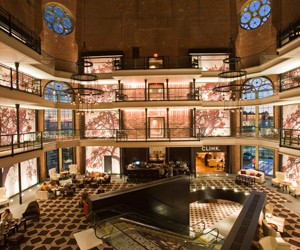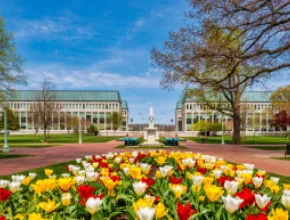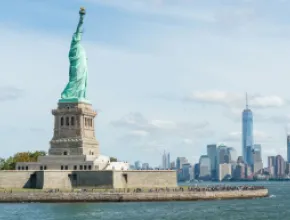Adaptive reuse, the hottest trend in urban redevelopment, is proving to be a boon for meetings. It’s hard to find a city where buildings no longer needed for their original purposes aren’t being transformed into hotels, museums, arts centers and other types of venues and visitor attractions.
New England, with its vast number of historic structures stemming from the days of wooden shipbuilding up through the Industrial Revolution and beyond, is where adaptive reuse is in full bloom. Planners looking for a hotel or off-site venue with intriguing history and architecture will find an expanding number of choices throughout the region.
Hotels
The Liberty Hotel
Ever since the Liberty Hotel opened its doors in 2007, doing time in jail has taken on a whole new meaning in Boston. The luxury 300-room property in a prime Beacon Hill location had once been the Charles Street Jail, sheltering prisoners, not guests, behind its imposing gray granite walls from1851 on up to 1990.
After an imaginative $150 million renovation, the original jail structure, with its catwalks and 90-foot central rotunda, houses the lobby, meeting rooms, restaurant, bar and a few of the guest rooms. Vestiges of the original jail cells can be seen in the lobby bar and there is also a gallery with historic photographs from the building’s earlier days.
Most of the guest rooms are in a new 16-story tower, many affording views of the nearby Charles River. The hotel maintains a fleet of bicycles for cycling along the river and has a partnership with Community Boating for free kayak rentals.
"When I first heard that a hotel was being made of out a jail, I assumed it would be dark, but the original structure, including the function space, is bathed in natural light," says Director of Sales Sean Reardon. "It’s an architectural gem, with exquisite ocular windows and plenty of exposed brick."
The hotel’s 6,000 square feet of meeting space includes a grand ballroom, while the rotunda and historic catwalks linking areas throughout the original structure are popular event sites, according to Reardon.
"We’ve used the catwalks for receptions and clients love them," he says. "You have a private area and yet you don’t lose the vibe of the building. When Virgin America launched service, we used three of the catwalks for a reception with Richard Branson."
Since the hotel’s opening, Reardon says meeting groups have accounted for about 35 percent of overall business at the hotel. The ideal group size is 150 or less.
Kendall Hotel
For nearly a century, a classic 19th century firehouse called Engine 7 housed stables with a permanent team of horses, coal bunkers to fuel steam-powered fire pumpers and dormitories for firemen, complete with brass poles to enable quick exits. For the past few years, the Queen Anne-style brick building has been the Kendall Hotel, a 73-room boutique property in Cambridge, Mass., filled with reminders of its original purpose.
"Our entire hotel is steeped in firehouse history, " says Brenda Anderson, group sales manager. "We’ve got firefighter memorabilia from around the country, including antique artifacts from the late 1800s. It’s like a little museum."
Closed in 1993, the building fell into disrepair, but was saved from demolition in 2000. An ambitious renovation effort included moving the three-story structure closer to the street and the construction of a seven-story addition.
"The new building was made to look like the original building, so it all looks seamless," Anderson says.
The reborn hotel includes a spacious lobby with a fireplace and a restaurant called the Black Sheep, named in honor of the firefighters who called themselves the "black sheep" of the Cambridge Fire Department. The most requested of its two meeting rooms is antiques-decorated Engine 7, which seats up to 12 at a board table and also accommodates receptions for up to 30 people.
Renaissance Providence Hotel
A stately Greek Revival-style edifice across from the Rhode Island State House, the Renaissance Providence Hotel looks like a grande dame of a hotel with a storied past. However, the building was actually intended to be a Masonic Temple before the Great Depression put a halt to its completion. Over seven decades later, the abandoned, unfinished building was purchased by Sage Hospitality and, after a three-year, $100 million project, emerged as a 272-room hotel in 2007.
Considered to be the most ambitious historic renovation in the history of Rhode Island, the original façade of the building was retained and restored, while the interior was refashioned to include a spacious lobby with views of the state house, a fitness center and 49 club-level guest rooms. The original building also contains Temple-Downtown, a destination restaurant and adjoining lounge that sports some of the original stonework.
A nine-story addition, built to house the 10,000 square feet of meeting space and additional guest rooms, links the original structure with the VMA Arts and Cultural Center, home to the Rhode Island Philharmonic and other performing arts groups.
"The hotel really tried to keep the integrity of what was to be a Masonic Temple, both with the exterior and interior," says Michael Barrett, director of sales and marketing for the Renaissance Providence. "We took the interior spaces and made them up-to-date with vibrant colors, but the lines of the temple are still here."
According to Barrett, the hotel is best suited for groups of 200 or less.
"We’re not a boutique, but we’re not a convention center hotel either," he says. "We’re a moderate-sized corporate hotel designed for the customer who needs the space for a general session and a couple of breakouts."
Portland Regency Hotel & Spa
Long a centerpiece of Portland’s historic Old Port area, the Portland Regency Hotel & Spa began life in 1895 as an armory for the Maine National Guard. After many years as an armory, followed by turns as a recreation center and a warehouse, the building was converted to a 95-room hotel in the mid-1980s.
The conversion project was careful to retain the building’s original neoclassical exterior, while incorporating the late 19th-century architectural details into the interior spaces.
"All of the guest rooms are different sizes and shapes to keep with the structure of the building," says Ann Tracy, sales manager. "Rooms on the third and fourth floors have skylights, while some have port holes and windows in the turrets. One of the meeting rooms has the original brickwork and fireplace."
While most meetings at the hotel are for groups of 80 or less, the hotel, which is available for buyouts, can accommodate 120 or more, according to Tracy. The hotel includes a restaurant, full-service spa and six conference rooms. A recent addition to the hotel is an outdoor garden cafe, which is available for receptions.
"We’re right in the middle of the Old Port, within walking distance of everything," Tracy says. ""Most of the groups end up taking one of the ferries to an offshore island for lobster bakes—those are great, fun events."
Cranwell Resort & Golf Club
Before becoming a luxury resort, Cranwell Resort & Golf Club went through turns as a Gilded Age mansion, country club and private school for boys. In 1853, the Reverend Henry Beecher, a noted abolitionist, advocate of women’s suffrage and brother of Uncle Tom’s Cabin author Harriett Beecher Stowe, purchased the hilltop site in the Berkshires of western Massachusetts, where the resort now stands. Enchanted with the views that stretched for over 60 miles, he proclaimed, "From here, I can see the very hills of heaven."
Furniture magnate John Sloane acquired the property in the 1890s, constructing the Tudor-style mansion, which now forms the nucleus of Cranwell Resort, as a summer "cottage." Sloane also commissioned Frederick Law Olmstead, the landscape architect who created New York’s Central Park, to design Cranwell’s extensive grounds.
Sold to Florida developers in 1925, the property was briefly run as the Berkshire Hunt and Country Club. After its purchase by Edward Cranwell in 1930, it then became a private school for boys until its closure in 1975.
Today the 380-acre property is a hotel with 114 guest rooms, suites and cottages. The splendor of the original mansion is evident in such areas as the Great Hall, with its rich paneling and French tapestries, and the Wyndhurst restaurant, an elegant room with oversized windows framing views of the Berkshires.
Amenities surrounding the original mansion include an 18-hole championship golf course (built during the 1920s country club phase), tennis courts, a glass-enclosed indoor swimming pool and a fitness center. Renovated last year, Cranwell’s 35,000-square-foot spa features 16 treatments rooms providing over 50 services.
Cranwell offers 15 meeting and banquet rooms, including six in the historic mansion, ranging from a stately boardroom to a grand ballroom accommodating up to 200 guests.
Castle Hill Inn
Over 100 years ago, Alexander Agassiz, an imminent Harvard scientist who is considered the father of modern oceanography, built a grand shingled summer retreat on Castle Hill, a coastal promontory in Newport, R.I. The estate, which grew to include extensive gardens and a laboratory designed to resemble a Swiss chalet, quickly became an important center for marine biological research that drew naturalists from around the globe.
Agassiz’s retreat is now Castle Hill Inn, an elegant property that still includes the original mansion with its turrets and spacious terrace overlooking Narragansett Bay. Guest rooms and suites are in the mansion and in newer structures that include luxury beachfront cottages. The inn, which offers numerous outdoor and indoor function spaces, is a popular site for corporate retreats, board meetings, business seminars, cocktail receptions and dinners.
Venues
Mystic Seaport
One of the nation’s earliest and most ambitious examples of historic preservation and adaptive reuse, Mystic Seaport in Mystic, Conn., is a vibrant visitor attraction and venue that illustrates the shipbuilding heritage of the Mystic River, a place where over 600,000 vessels were constructed between 1784 and 1919. In 1929 three local businessmen, concerned that the wooden shipbuilding heritage would be lost, created a maritime museum complex out of two of the original working shipyards.
Today Mystic Seaport includes a replicated 19th century seafaring village, created from both buildings original to the site and others brought in from around New England, as well as maritime exhibit galleries and a preservation shipyard where skilled craftspeople use 19th century tools to preserve the museum’s vast collection of historic vessels.
The meetings-friendly complex offers a wide range of event spaces and team-building activities, accord to Sarah Spencer, group sales manager.
"For smaller groups, we’ve done team building where we use replicas of whaling boats that require five people to row together as a team—the oars are staggered, so it really requires a team effort," she says. "We also have an activity where teams have to put a wooden barrel together. It’s a combination of history and learning cooperation."
Groups can also observe restoration work on Mystic Seaport’s most ambitious preservation project: the restoration of the Charles W. Morgan, the world’s last surviving wooden whale ship, which has been at the museum since 1941.
"People can go onboard the ship, learn about its history and witness something that is a once-in-a-lifetime restoration effort," Spencer says. "Everything below the water line is being replaced in a historic fashion. She hasn’t been sailed since 1921, but we hope to sail her once again in 2013."
Mystic Seaport offers a wide variety of event spaces for groups of all sizes on its 19-acre site. A variety of function rooms hold groups of up to 200, while a large lawn area, which can be tented, is available for large events.
"We’ve also got Lighthouse Point, a thumb of land that sticks out into the river and has a boat shed pavilion. It’s a great site for clambakes and cookouts for up to 400 people," Spencer says. "A lot of our events include entertainment with a 19th century maritime feel—musicians doing historic seafaring music."
One of the site’s more unique venues is the S.S. Sabino, an 80-passenger steamboat that can be chartered for catered cruises up the Mystic River. The 1908 vessel is the nation’s last operating coal-fired steamboat.
"Because it’s steam powered, you don’t get any engine noise and so it’s an incredible smooth and quiet experience," Spencer says. "Passengers can watch the engineer shovel coal into boiler and chat with him."
Amoskeag Millyard: Millyard Museum
SEE Science Center
The 19th century red brick buildings of Amoskeag Millyard, once the center for the world’s largest textile manufacturing operations, still dominate the Manchester, N.H., cityscape, but they serve different purposes today. Along with offices, the buildings house two engaging visitor attractions: the Millyard Museum and the SEE Science Center.
Operated by the Manchester Historic Association, the Millyard Museum features a permanent exhibit called Woven in Time: 11,000 Years at Amoskeag Falls, which starts with the region’s earliest history and continues on up to the development of the Amoskeag Manufacturing Company, which at its zenith employed 17,000 people, including immigrants from around the world. With selections from the museum’s 600,000 documents and artifacts, the exhibit includes activity stations, a model of the millyard, looms from the mills, a 19th century fire pumper and more.
The museum’s Discovery Gallery is its main function space, accommodating up to 100 people for seated events.
Although only available to scientific organizations for events, the SEE Science Center welcomes visitors to enjoy its hands-on exhibits pertaining to science, mathematics and technology. Its major attraction is the Millyard Lego Project, which is made of up of 3 million LEGO blocks depicting the Amoskeag complex and is reportedly the largest permanent LEGO installation in the world.
Firehouse Center for the Visual Arts
With its 85-foot high bell tower, the building originally known as the Ethan Allen Firehouse has been an iconic landmark in downtown Burlington, Vt., since its completion in 1889. For over 80 years, the building was home to one of Burlington’s volunteer fire departments as well as a place for firefighters to socialize and relax.
In the 1990s, Burlington City Arts formed a plan to convert the building to a place where visual artists could create and display their work. Today the former firehouse, while retaining the bell tower and other historic architectural features, has been redesigned to offer art exhibits, art studios, a community darkroom, a library and a multimedia conference area for lectures and films.
Available for rent, the entire building accommodates up to 400 people for a catered reception. Other spaces include the Firehouse Gallery, which holds up to 140 people, and The Plaza, an outdoor space for up to 100 people.







